Your browser does not fully support modern features. Please upgrade for a smoother experience.

Submitted Successfully!
Thank you for your contribution! You can also upload a video entry or images related to this topic.
For video creation, please contact our Academic Video Service.
| Version | Summary | Created by | Modification | Content Size | Created at | Operation |
|---|---|---|---|---|---|---|
| 1 | Muhammad Khan | + 1266 word(s) | 1266 | 2021-12-03 09:01:15 | | | |
| 2 | Rita Xu | Meta information modification | 1266 | 2021-12-16 03:03:30 | | |
Video Upload Options
We provide professional Academic Video Service to translate complex research into visually appealing presentations. Would you like to try it?
Cite
If you have any further questions, please contact Encyclopedia Editorial Office.
Khan, M. Fascioliasis Research. Encyclopedia. Available online: https://encyclopedia.pub/entry/17157 (accessed on 13 January 2026).
Khan M. Fascioliasis Research. Encyclopedia. Available at: https://encyclopedia.pub/entry/17157. Accessed January 13, 2026.
Khan, Muhammad. "Fascioliasis Research" Encyclopedia, https://encyclopedia.pub/entry/17157 (accessed January 13, 2026).
Khan, M. (2021, December 15). Fascioliasis Research. In Encyclopedia. https://encyclopedia.pub/entry/17157
Khan, Muhammad. "Fascioliasis Research." Encyclopedia. Web. 15 December, 2021.
Copy Citation
Fascioliasis is a zoonotic neglected tropical disease caused by Fasciola hepatica and F. gigantica. In endemic regions, fascioliasis represents a huge problem in livestock production and significantly threatens public health.
fascioliasis
bibliometric analysis
research trend
1. Introduction
Fascioliasis is a waterborne and foodborne zoonotic disease caused by the trematode species Fasciola hepatica and F. gigantica [1]. F. hepatica has a worldwide distribution, and it is reported in Asia, Europe, America, Oceania, and Africa, whereas F. gigantica is reported in Africa and Asia [1]. In veterinary medicine, the severity of animal fascioliasis affects animals to different extents, depending on the host and parasitic burden. The clinical signs can vary from asymptomatic to a devastating disease (e.g., weight loss, reduced milk production yield, and diminished fertility) including death, which leads to heavy economic losses [2][3][4][5][6].
In the 1980s, human fascioliasis was only considered a secondary disease. However, the increased infection by F. hepatica in humans, reported in the 1990s, increased the importance of this disease in public health. [7][8]. To date, human fascioliasis should be considered a significant human parasitic disease [7]. Human infection by infective metacercariae (trematoda) can be ingested through freshwater wild plants, freshwater cultivated plants, drinking of contaminated water, and raw liver infected with metacercariae [9]. A recent review [10] has widened the spectrum of human infection sources to include: (1) ingestion of freshwater wild plants, (2) ingestion of freshwater cultivated plants, (3) ingestion of terrestrial wild plants, (4) ingestion of terrestrial cultivated plants, (5) ingestion of traditional local dishes made with contaminated sylvatic plants, (6) ingestion of raw liver, (7) drinking of contaminated water, (8) drinking of beverages and juices made from local plants, (9) ingestion of dishes and soups made with contaminated water, and (10) washing of vegetables, fruits, tubercles, kitchen utensils or other objects with contaminated water.
The long life span of fasciolids in humans is up to 13.5 years [11], which underlies complications and sequelae in long-term chronicity. The most common complications are cholecystitis, biliary obstruction, liver abscesses, subcapsular haemorrhages, and recurrent cholangitis [12]. Other complications include biliary colics, lithiasis, anaemia, and bacteriobilia [13][14][15]. In Turkey, two rare cases of fascioliasis showed tumor-like lesions in the liver [16]. Ectopic fascioliasis can occur in different organs such as the abdominal wall and spleen but not the liver [17]. Others are in the abdominal wall, spleen, pancreas, subcutaneous tissue, blood vessels, heart, lung and pleural cavity, skeletal muscle, epididymis, and appendix [11][18]. The pathogenic and physiological mechanisms underlying neurofascioliasis and ophthalmofascioliasis are restricted to the sporadic cases in which the direct affection of the central nervous system or the eye is caused by a migrant ectopic fasciolid fluke. On the contrary, relatively frequent, or less rare are situations in which fascioliasis infection in the liver gives an indirect rise to neurological affection and similarly are those cases of fascioliasis infection in the liver indirectly causing ocular manifestations [19]. Fascioliasis is easy to diagnose in areas where the infection is endemic; however, the diagnosis is difficult where cases are only detected sporadically [20][21].
2. Publication Growth
After excluding the following documents: corrections (n = 26), book reviews and chapters (n = 14), news items (n = 02), discussions (n = 02), and retracted publications (n = 01), a total of 4,165 documents published between 1913 and 3 October 2021 were included in the final analysis. These documents were cited 66,518 times with an average of 15.97 citations per document and an overall H-index of 86. The most productive year in terms of published documents was 2018 (n = 108, 2.6%), followed by 2015 (n = 107, 2.6%), 2011 (n = 104, 2.5%), then 2020 (n = 102, 2.4%) and, so far, (n = 69, 1.7%) 2021, as shown in Figure 1.
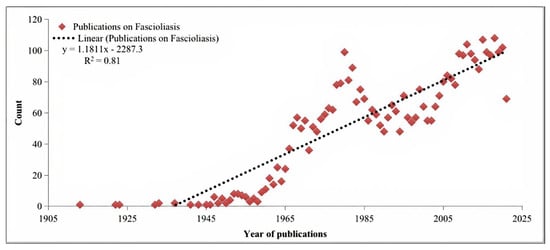
Figure 1. Time trend of publications on fascioliasis from 1903 to 2021.
3. Document Types, Languages, Funding Agencies, and Most-Studied Research Areas
In total, the highest number of published documents were research articles (n = 3378, 81.1%), meeting abstracts (n = 318, 7.6%), and review articles (n = 54, 1.3%), and the remaining documents (n = 415, 10.0%) were either notes, letters, editorial material, or proceeding articles. Most of the documents were published in the English language (n = 3853, 92.5%), and the majority of all included studies were funded by European Commission (n = 162, 3.9%). The most-studied research area was parasitology (n = 1833, 44%), followed by veterinary sciences (n = 1254, 30.1%) and tropical medicine (n = 387, 9.3%). Figure 2 shows the full details.
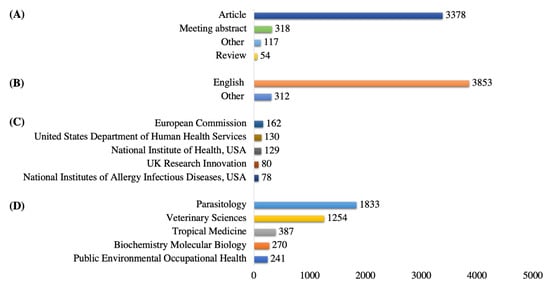
Figure 2. (A) Document types, (B) publishing languages, (C) top five funding agencies, (D) top five most-studied research areas in fascioliasis.
4. Top Five Leading Authors, Journals, Institutions, and Countries
The author who published the highest number of documents in fascioliasis research was Rondelaud, D (n = 156, 3.7%), followed by Fairweather, I (n = 129, 3.1%), and Dalton, JP (n = 97, 2.3%). The journals that attracted the highest number of publications were Veterinary Parasitology (n = 324, 7.8%), then Parasitology (n = 237, 5.7%). Approximately 40% of the published documents were from the journals hosted by Elsevier (n = 1222, 29.3%) and Springer Nature (n = 426, 10.2%). Queen’s University Belfast was the most active institution producing published documents related to fascioliasis research (n = 250, 6%), followed by the University of Puerto Rico (n = 112, 2.6%) and the University of Valencia (n = 111, 2.6%). The highly contributing countries were the USA (n = 482, 11.6%), France (n = 333, 8%), and England (n = 330, 7.9%). Figure 3 shows the full details.
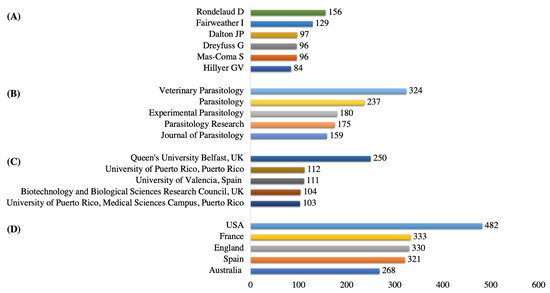
Figure 3. (A) Top five authors, (B) top five journals, (C) top five institutions, (D) top five countries in fascioliasis research.
5. Top Ten Most-Cited Papers in Fascioliasis
The most-cited document in fascioliasis research was “Fascioliasis and other plant-borne trematode zoonoses” (Mas-Coma et al., 2005b) with 521 citations. Among the top ten most-cited documents, there were seven articles, two reviews, and one note. Table 1 shows the full details.
Table 1. Top ten most-cited papers in fascioliasis research.
| Raking | Title | Paper Type | Total Citations | Average Per Year | Citations in | |
|---|---|---|---|---|---|---|
| 2020 | 2021 | |||||
| 1st | Fascioliasis and other plant-borne trematode zoonoses [22] | Review | 521 | 30.65 | 46 | 21 |
| 2nd | Epidemiology of human fascioliasis: a review and proposed new classification [7] | Article | 280 | 12.17 | 10 | 5 |
| 3rd | Epidemiology of fascioliasis in human endemic areas [8] | Article proceeding paper | 224 | 13.18 | 22 | 8 |
| 4th | Effects of serotonin (5-hydroxytryptamine) and adenosine 3′,5′-phosphate on phosphofructokinase from liver fluke Fasciola hepatica [23] | Article | 218 | 3.63 | 1 | 0 |
| 5th | Treatment of immature and mature Fasciola-hepatica infections in sheep with triclabendazole [24] | Article | 210 | 5.38 | 8 | 3 |
| 6th | Climate change effects on trematodiases, with emphasis on zoonotic fascioliasis and schistosomiasis [25] | Article proceeding paper | 208 | 16 | 19 | 9 |
| 7th | Thioredoxin peroxidase secreted by Fasciola hepatica induces the alternative activation of macrophages [26] | Article | 207 | 12.18 | 16 | 10 |
| 8th | An integrated transcriptomics and proteomics analysis of the secretome of the helminth pathogen Fasciola hepatica proteins associated with invasion and infection of the mammalian host [27] | Article | 198 | 15.23 | 19 | 12 |
| 9th | Fasciola hepatica cathepsin L-like proteases: biology, function, and potential in the development of first generation liver fluke vaccines [28] | Review | 198 | 10.42 | 8 | 8 |
| 10th | Resistance of Fasciola-hepatica to triclabendazole [29] | Note | 197 | 7.3 | 8 | 7 |
6. Co-Authorship Countries Network Visualization
The minimum number of documents of a country was fixed at five. Of the 116 countries, 65 countries met the threshold and were plotted. Based on publications, the USA was the leading country in terms of published studies, while, based on the TLS, Spain was the most influential country with a TLS of 236, followed by the USA (TLS = 178) then England (176), as shown in Figure 4.
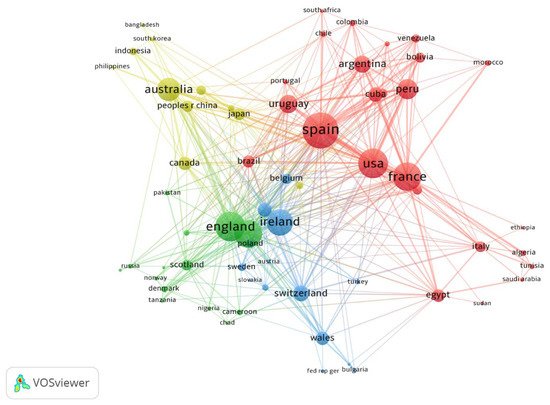
Figure 4. Co-authorship countries network visualization based on TLS.
7. Co-Occurrence All Keywords Network Visualization
The minimum number of occurrences of a keyword was set at 20. Of the total 5560 keywords, 166 keywords met the threshold and were plotted for network visualization. The most widely used keyword was “F. hepatica” with a total of 821 occurrences (TLS = 3803), followed by “cattle” (occurrences = 436; TLS = 2,431) and “sheep” (occurrences = 382; TLS = 2160), as shown in Figure 5.

Figure 5. Network visualization of co-occurrences of all keywords based on occurrences.
8. Bibliographic Coupling Sources Network Visualization
The minimum number of documents of a source was ten. Of the total 630 sources, 68 met the threshold and were plotted. The Veterinary Parasitology had the highest TLS 122,834, followed by Parasitology Research (TLS = 66,099) and Parasitology (TLS = 56,295), as shown in Figure 6.

Figure 6. Network visualization of bibliographic coupling sources based on documents.
9. Documents Citation Network Visualization
The minimum number of citations of a document was selected at 50. Of the total documents, only 258 met the threshold and were plotted. Mas-Coma (2005a) was the most cited document, followed by Mas-Coma (1999) and Mas-Coma (2005b), as shown in Figure 7.
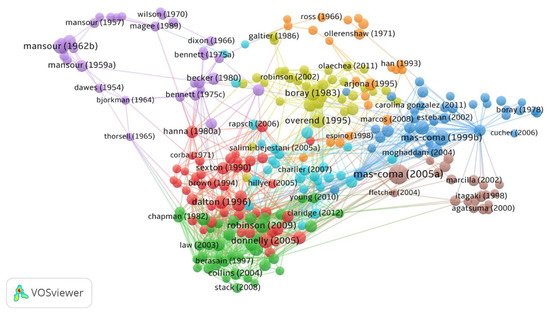
Figure 7. Network visualization of citation and documents based on citations.
References
- Mas-Coma, S.; Valero, M.A.; Bargues, M.D. Fasciola, lymnaeids and human fascioliasis, with a global overview on disease transmission, epidemiology, evolutionary genetics, molecular epidemiology and control, Chapter 2. Adv. Parasitol. 2009, 69, 41–146.
- El-Tahawy, A.S.; Kwan, N.; Sugiura, K. Fasciola hepatica infection in water buffalo Bubalus bubalis in three provinces of the Nile Delta, Egypt: A cross-sectional study. J. Vet. Med. Sci. 2018, 80, 28–35.
- Chen, M.; Mott, K. Progress in assessment of morbidity due to Fasciola hepatica infection: A review of recent literature. Trop. Dis. Bull. 1990, 87, R1–R38.
- Ibrahim, N. Fascioliasis: Systematic review. Adv. Biol. Res. 2017, 11, 278–285.
- Kaplan, R.M. Fasciola hepatica: A review of the economic impact in cattle and considerations for control. Vet. Ther. 2001, 2, 40–50.
- Schweizer, G.; Braun, U.; Deplazes, P.; Torgerson, P.R. Estimating the financial losses due to bovine fasciolosis in Switzerland. Vet. Rec. 2005, 157, 188–193.
- Mas-Coma, M.S.; Esteban, J.G.; Bargues, M.D. Epidemiology of human fascioliasis: A review and proposed new classification. Bull. World Health Organ. 1999, 77, 340–346.
- Mas-Coma, S. Epidemiology of fascioliasis in human endemic areas. J. Helminthol. 2005, 79, 207–216.
- Mas-Coma, S. Human fascioliasis. In Waterborne Zoonoses: Identification, Causes and Control; Cotruvo, J.A., Dufour, A., Rees, G., Bartram, J., Carr, R., Cliver, D.O., Craun, G.F., Fayer, R., Gannon, V.P.J., Eds.; World Health Organization (WHO) and IWA Publishing: London, UK, 2004; pp. 305–322.
- Mas-Coma, S.; Bargues, M.D.; Valero, M.A. Human fascioliasis infection sources, their diversity, incidence factors, analytical methods and prevention measures. Parasitology 2018, 145, 1665–1699.
- Mas-Coma, S.; Bargues, M. Human liver flukes: A review. Res. Rev. Parasitol. 1997, 57, 145–218.
- Arjona, R.; Riancho, J.A.; Aguado, J.M.; Salesa, R.; Gonzalez-Macias, J. Fascioliasis in developed countries: A review of classic and aberrant forms of the disease. Medicine 1995, 74, 13–23.
- Valero, M.A.; Santana, M.; Morales, M.; Hernandez, J.L.; Mas-Coma, S. Risk of gallstone disease in advanced chronic phase of fascioliasis: An experimental study in a rat model. J. Infect. Dis. 2003, 188, 787–793.
- Valero, M.A.; Navarro, M.; Garcia-Bodelon, M.A.; Marcilla, A.; Morales, M.; Hernandez, J.L.; Mengual, P.; Mas-Coma, S. High risk of bacterobilia in advanced experimental chronic fasciolosis. Acta Trop. 2006, 100, 17–23.
- Valero, M.A.; Girones, N.; Garcia-Bodelon, M.A.; Periago, M.V.; Chico-Calero, I.; Khoubbane, M.; Fresno, M.; Mas-Coma, S. Anaemia in advanced chronic fasciolosis. Acta Trop. 2008, 108, 35–43.
- Samdanci, E.; Sahin, N.; Dagli, A.F.; Akatli, A.N.; Aydin, N.E. Fascioliasis: A Rare Parasitic Infection-Mimicking Tumor in the Liver: Report of Two Cases. Turk. Patoloji Derg. 2019, 35, 58–60.
- Taghipour, A.; Zaki, L.; Rostami, A.; Foroutan, M.; Ghaffarifar, F.; Fathi, A.; Abdoli, A. Highlights of human ectopic fascioliasis: A systematic review. Infect. Dis. 2019, 51, 785–792.
- Mas-Coma, S.; Bargues, M.D.; Valero, M.A. Diagnosis of human fascioliasis by stool and blood techniques: Update for the present global scenario. Parasitology 2014, 141, 1918–1946.
- Mas-Coma, S.; Agramunt, V.H.; Valero, M.A. Neurological and ocular fascioliasis in humans. Adv. Parasitol. 2014, 84, 27–149.
- Cook, G.C.; Zumla, A. Manson’s Tropical Diseases; Elsevier Health Sciences: Amsterdam, The Netherlands, 2008.
- Gordon, D.K.; Zadoks, R.N.; Stevenson, H.; Sargison, N.D.; Skuce, P.J. On farm evaluation of the coproantigen ELISA and coproantigen reduction test in Scottish sheep naturally infected with Fasciola hepatica. Vet. Parasitol. 2012, 187, 436–444.
- Mas-Coma, S.; Bargues, M.D.; Valero, M.A. Fascioliasis and other plant-borne trematode zoonoses. Int. J. Parasitol. 2005, 35, 1255–1278.
- Mansour, T.E.; Mansour, J.M. Effects of serotonin (5-hydroxytryptamine) and adenosine 3’,5’-phosphate on phosphofructokinase from the liver fluke Fasciola hepatica. J. Biol. Chem. 1962, 237, 629–634.
- Boray, J.C.; Crowfoot, P.D.; Strong, M.B.; Allison, J.R.; Schellenbaum, M.; Von Orelli, M.; Sarasin, G. Treatment of immature and mature Fasciola hepatica infections in sheep with triclabendazole. Vet. Rec. 1983, 113, 315–317.
- Mas-Coma, S.; Valero, M.A.; Bargues, M.D. Climate change effects on trematodiases, with emphasis on zoonotic fascioliasis and schistosomiasis. Vet. Parasitol. 2009, 163, 264–280.
- Donnelly, S.; O’Neill, S.M.; Sekiya, M.; Mulcahy, G.; Dalton, J.P. Thioredoxin peroxidase secreted by Fasciola hepatica induces the alternative activation of macrophages. Infect. Immun. 2005, 73, 166–173.
- Robinson, M.W.; Menon, R.; Donnelly, S.M.; Dalton, J.P.; Ranganathan, S. An integrated transcriptomics and proteomics analysis of the secretome of the helminth pathogen Fasciola hepatica: Proteins associated with invasion and infection of the mammalian host. Mol. Cell. Proteom. 2009, 8, 1891–1907.
- Dalton, J.P.; Neill, S.O.; Stack, C.; Collins, P.; Walshe, A.; Sekiya, M.; Doyle, S.; Mulcahy, G.; Hoyle, D.; Khaznadji, E.; et al. Fasciola hepatica cathepsin L-like proteases: Biology, function, and potential in the development of first generation liver fluke vaccines. Int. J. Parasitol. 2003, 33, 1173–1181.
- Overend, D.J.; Bowen, F.L. Resistance of Fasciola hepatica to triclabendazole. Aust. Vet. J. 1995, 72, 275–276.
More
Information
Subjects:
Zoology
Contributor
MDPI registered users' name will be linked to their SciProfiles pages. To register with us, please refer to https://encyclopedia.pub/register
:
View Times:
669
Revisions:
2 times
(View History)
Update Date:
16 Dec 2021
Notice
You are not a member of the advisory board for this topic. If you want to update advisory board member profile, please contact office@encyclopedia.pub.
OK
Confirm
Only members of the Encyclopedia advisory board for this topic are allowed to note entries. Would you like to become an advisory board member of the Encyclopedia?
Yes
No
${ textCharacter }/${ maxCharacter }
Submit
Cancel
Back
Comments
${ item }
|
More
No more~
There is no comment~
${ textCharacter }/${ maxCharacter }
Submit
Cancel
${ selectedItem.replyTextCharacter }/${ selectedItem.replyMaxCharacter }
Submit
Cancel
Confirm
Are you sure to Delete?
Yes
No




